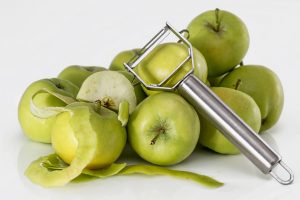 There are several ways to prepare apples for applesauce, as well as other pome fruits, including pears and quince. In this article, we describe several tools and appliances for preparing apples, pears, and quince to make sauce. In addition, we offer several ways to prevent browning of these fruits during preparation and several different methods (using different tools and equipment) for turning the fruit into applesauce, pear sauce, or quince sauce. Finally, we’ve included a recipe for quince paste. If you are looking for a recipe for fruit butter, here’s a link to a low-sugar recipe for pear butter or apple butter. For more ideas for preserving apples and pears and many other types of foods, get the book The Home Preserving Bible by Carole Cancler.
There are several ways to prepare apples for applesauce, as well as other pome fruits, including pears and quince. In this article, we describe several tools and appliances for preparing apples, pears, and quince to make sauce. In addition, we offer several ways to prevent browning of these fruits during preparation and several different methods (using different tools and equipment) for turning the fruit into applesauce, pear sauce, or quince sauce. Finally, we’ve included a recipe for quince paste. If you are looking for a recipe for fruit butter, here’s a link to a low-sugar recipe for pear butter or apple butter. For more ideas for preserving apples and pears and many other types of foods, get the book The Home Preserving Bible by Carole Cancler.
Tools and appliances to prepare fruits for sauce
There are several tools and appliances you can use to peel, core, and puree apples. Which one you chooses depends on your budget, the amount of fruit you want to prepare, and how easy you want to make the job.
- If you only prepare a small number of apples (say, up to five pounds—that’s about 15 medium apples), then preparing apples by hand is not an overwhelming chore. You probably already have tools or appliances that can help you accomplish the task: a peeler and a small sharp knife. A wire mesh strainer or food mill
can finish the job, or you may want to enlist the aid of a countertop blender or hand blender
.
- If you routinely prepare larger batches of apples (between 5 and 20 pounds), then you may want to invest in tools that make such a large task easier. For the budget conscious, a manual apple peeler-corer-slicer
can do the job. In fact, if you want to prepare apple slices for pie, as well as peel and core for applesauce, this modest investment is a great tool to use along with a strainer, food mill, or blender.
- If you routinely want to prepare many large batches, or an entire box or bushel of apples (about 40 pounds), then consider an electric appliance. If you have a KitchenAid mixer, you might want to buy the KitchenAid vegetable strainer attachment
, which also requires the KitchenAid food grinder attachment
.
- If you routinely deal with more than 40 pounds or have an apple tree (which can average 800 pounds of apples per year), you will likely want to invest in a standalone electric food strainer appliance
to deal with this much volume.
How to prevent browning of peeled or cut apples, pears, and quince
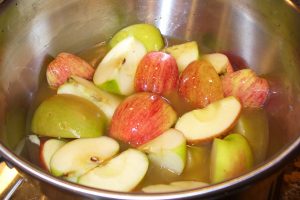 When you cut into apples, pears, or quince, the flesh will turn brown. The short explanation? Enzymes oxidize the fruit, which turns it brown. Now, oxidation is not always a bad thing. Oxidation occurs when you ferment grapes to make red wine or dehydrate grapes to make raisins. However, when you want to make a fruit sauce with white, fleshy fruits such as apples, browning is unappetizing, though not harmful. To retain the pale color of the fruit, you need to deactivate the enzymes that cause unwanted oxidation to occur. There are several ways to do prevent browning when preparing pome fruits. Which method you use is a matter of personal preference. My favorites are ascorbic acid or water with lemon juice; they’re both easy and effective.
When you cut into apples, pears, or quince, the flesh will turn brown. The short explanation? Enzymes oxidize the fruit, which turns it brown. Now, oxidation is not always a bad thing. Oxidation occurs when you ferment grapes to make red wine or dehydrate grapes to make raisins. However, when you want to make a fruit sauce with white, fleshy fruits such as apples, browning is unappetizing, though not harmful. To retain the pale color of the fruit, you need to deactivate the enzymes that cause unwanted oxidation to occur. There are several ways to do prevent browning when preparing pome fruits. Which method you use is a matter of personal preference. My favorites are ascorbic acid or water with lemon juice; they’re both easy and effective.
- Ascorbic acid (also known as vitamin C) is safe and effective for treating fruits and vegetables to retard the enzyme oxidation that causes browning. Vitamin C is economical and available anywhere vitamins are sold. Be sure to buy plain tablets, not time-released, and without aded ingredients such as bioflavonoids, color, or flavoring. To prepare a soaking solution, use 3,000 milligrams per gallon of water. For example, crush six 500-milligram tablets and stir into one gallon water until dissolved. Cut fruits directly into the ascorbic-acid solution and allow to soak 5 minutes, drain well, and pat dry.
- Citric acid prevents browning, but is not as effective as ascorbic acid. Citric acid powder is widely available: check grocery stores, drug stores, health food stores, or stores where canning or candy-making supplies are sold. To prepare a citric-acid powder solution, stir 1 teaspoon (5 grams) of citric acid into 1 quart (1,000 milliliters) of cold water. Cut fruits directly into the citric-acid solution and allow to soak 5 minutes, drain well, and pat dry.
- Fruit juice that is high in ascorbic or citric acid will help retard browning. Fruit juices you can use full strength include apple, cranberry, white grape, orange, or pineapple. They may be freshly squeezed or commercially bottled juices without added sugar. Lemon or lime juice also works well; add 3-4 tablespoons fresh or bottled lemon or lime juice to each quart of water. Cut fruits or vegetables directly into the juice and allow to soak 5 minutes, drain well, and pat dry.
- Commercial antioxidants, such as Fruit-Fresh, are easy to use and readily available where canning supplies are sold. However, these products tend to be more expensive than plain ascorbic acid, may have a shorter shelf life, and may contain additives (such as sugars and anticaking agents), as well as altered forms of ascorbic acid (for example, erythorbic acid) with no vitamin benefit. In addition, I have found these products to unnaturally alter the color of some fruits such as peaches. To use these products, follow the dosage and directions on the product label.
Basic recipe for applesauce, pear sauce, and quince paste
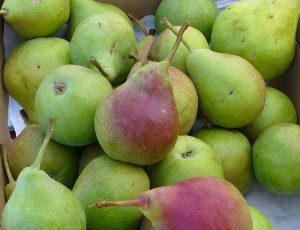 Here’s a simple, adaptable recipe to make one quart (or more) of applesauce, pear sauce, or quince sauce. Tart or cooking varieties of apples and pears tend to produce light, fresh-tasting applesauce, while sweet varieties create a more fragrant, fruitier sauce. All are delicious. Many cooks like to combine different varieties of fruits, or combine pears or quince with apples to get the best of all worlds. The natural color of applesauce, pear sauce, and quince sauce can range from yellow to fawn to rose, depending on the varieties and combinations of fruits used.
Here’s a simple, adaptable recipe to make one quart (or more) of applesauce, pear sauce, or quince sauce. Tart or cooking varieties of apples and pears tend to produce light, fresh-tasting applesauce, while sweet varieties create a more fragrant, fruitier sauce. All are delicious. Many cooks like to combine different varieties of fruits, or combine pears or quince with apples to get the best of all worlds. The natural color of applesauce, pear sauce, and quince sauce can range from yellow to fawn to rose, depending on the varieties and combinations of fruits used.
Makes about 1 quart sauce; recipe may be multiplied as needed
Ingredients
- 2½ pounds (7-8 medium) apples, washed
- ½ cup water or apple juice, or as needed to prevent sticking
- 2 to 4 tablespoons sweetener (almost any type will work: cane sugar, date sugar, maple sugar, coconut sugar, Splenda, powdered stevia, honey, maple syrup, or corn syrup), or to taste
- 1 to 2 tablespoons lemon juice (optional), or to taste
- ¼ teaspoon salt (optional), or to taste
Directions
Prepare applesauce using one of the following methods. Which method you use is a matter or preference, but also depends on the number of apples you plan to prepare, your kitchen skills, and available equipment.
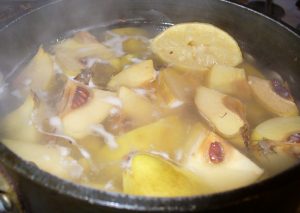 Method 1 (cook without coring, and then strain to puree): There is no need to peel apples with this method, since the fruit is strained after cooking. Straining removes the core as well as the peel. Cut apples into quarters. Use one of the above methods to prevent browning of the cut fruit. Place apple quarters in a saucepan with water or juice, cover, and cook over medium heat 15-30 minutes, or until soft. Add additional water if needed to prevent sticking. Strain cooked fruit using a wire mesh strainer, food mill, or chinois. Add more water or juice as needed to thin sauce to desired consistency.
Method 1 (cook without coring, and then strain to puree): There is no need to peel apples with this method, since the fruit is strained after cooking. Straining removes the core as well as the peel. Cut apples into quarters. Use one of the above methods to prevent browning of the cut fruit. Place apple quarters in a saucepan with water or juice, cover, and cook over medium heat 15-30 minutes, or until soft. Add additional water if needed to prevent sticking. Strain cooked fruit using a wire mesh strainer, food mill, or chinois. Add more water or juice as needed to thin sauce to desired consistency.- Method 3 (core, cook, and then puree): Peel fruit if desired; however, many cooks prefer to puree apples with the peel intact. With or without the peel, cut the fleshy portion from the core and discard the cores. Use one of the above methods to prevent browning of the cut fruit. Place apple pieces in a saucepan with water or juice, cover, and cook over medium heat 15-30 minutes, or until soft. Add additional water if needed to prevent sticking. Puree cooked apples until chunky or smooth as desired. To make smooth applesauce, use a strainer or food mill. To make chunky applesauce, pulse the apples using a countertop blender or hand blender. Add more water or juice as needed to thin sauce to desired consistency.
- Method 2 (bake, and then peel, quarter, and core; then puree): Place apples in a shallow baking pan, cover with foil, and bake in a 350°F oven for about 2 hours, or until tender all the way through when pierced with a sharp knife. Remove pan from oven, uncover, and allow to apples to cool. If desired, peel apples. Cut apples into quarters and trim out the core. Puree apples until chunky or smooth as desired. To make smooth applesauce, use a strainer or food mill. To make chunky applesauce, pulse the apples using a countertop blender or hand blender. Add water or juice as needed to thin sauce to desired consistency.
- Method 4 (peel, quarter and core by hand and then cook): For small batches (15 apples or less), you can peel, core and cut apples by hand using a peeler and a knife. For larger batches, you may want to use an economical manual apple peeler-corer-slicer. Use one of the above methods to prevent browning of the cut fruit. Puree the apple flesh using a blender or food processor, adding water as needed to facilitate processing. If you want to eat the applesauce fresh (within 3 days) or freeze it (up to one year), cooking is not necessary. However, if uncooked, add sugar and lemon juice to prevent further browning and to protect the fresh flavor and color of the fruit. To cook raw applesauce, transfer to a sauce pan, cover, bring to a boil over medium heat, and then reduce heat and simmer for 5 minutes. Add a small amount of water if needed to prevent sticking.
- Method 4 (remove cores and peels using specialized equipment, and then cook): To accomplish peeling, coring, and pureeing in one step, use a manual or electric fruit and vegetable strainer appliance. If you want to eat the applesauce fresh (within 3 days) or freeze it (up to one year), cooking is not necessary. However, if uncooked, add lemon juice to prevent further browning and to protect the fresh flavor of the fruit. To cook applesauce, transfer to a sauce pan, cover, bring to a boil over medium heat, and then reduce heat and simmer for 5 minutes. Add a small amount of water if needed to prevent sticking.
To finish the applesauce, add sweetener to taste. A small amount of lemon juice and/or salt can also enhance the flavor of the sauce. If granulated sugar or sweetener is added, continue to cook until sugar is completely dissolved. Cool completely, cover and refrigerate up to 3 days. For longer storage, applesauce may be frozen or canned.
- To freeze applesauce: pack chilled cooked or raw applesauce into freezer-safe containers. Freeze up to 12 months.
- To can applesauce: It is not safe to can raw applesauce. Bring applesauce to a boil over medium heat, and then reduce heat and simmer for 5 minutes. Add a small amount of boiling water if needed to prevent sticking or to thin the sauce to desired consistency. Keep sauce hot while filling jars. Adjust headspace to ½-inch. Process pints of applesauce for 15 minutes or quarts for 20 minutes (at 0 to 1,000 feet). If you are new to canning, read How to get started with the canning preservation method and download this free Tip Sheet for Home Food Canning.
Pear and quince variations. To make pear sauce: Pear sauce is made in exactly the same way as applesauce. Substitute 2½ pounds pears for the apples and proceed as directed. Freeze or can pear sauce in the same way as applesauce. To make quince sauce: Quince sauce is made in the same way as applesauce. Substitute 2½ pounds quince for the apples and proceed as directed. However, you will likely need to increase the cooking time; quince can take as long as an hour to become soft. Freeze or can quince sauce in the same way as applesauce.
Recipe for quince paste
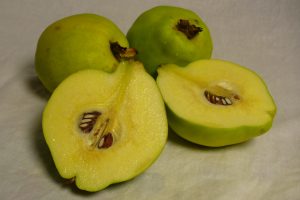 Quince sauce is often cooked with generous amounts of sugar and reduced until it becomes a thick paste, known as membrillo in Spanish. Throughout history, Greeks, Romans, Arabs, and especially the Portuguese made marmelada (i.e. quince paste or quince jam, also called quince cheese). During the 14th century, Portuguese explorers poured marmelada into special molds and traded the commodity around the world. You can find images of quince molds here and here and here. Today, you could use small gelatin molds or ramekins. In 17th century England, quince paste was known as quiddany or cotoniack the precursor to marmalade now most commonly made from sour oranges.
Quince sauce is often cooked with generous amounts of sugar and reduced until it becomes a thick paste, known as membrillo in Spanish. Throughout history, Greeks, Romans, Arabs, and especially the Portuguese made marmelada (i.e. quince paste or quince jam, also called quince cheese). During the 14th century, Portuguese explorers poured marmelada into special molds and traded the commodity around the world. You can find images of quince molds here and here and here. Today, you could use small gelatin molds or ramekins. In 17th century England, quince paste was known as quiddany or cotoniack the precursor to marmalade now most commonly made from sour oranges.
Makes about 1 quart sauce
Ingredients
- 1 quart unsweetened quince sauce (use the preceding recipe; you may want to add up to 4 cups water during cooking to facilitate softening of the fruit)
- 2 cups sugar
Directions
- In a saucepan, stir together the unsweetened quince sauce and sugar. Bring to a boil over medium heat. Reduce heat and simmer uncovered 30-60 minutes, or until sauce becomes deeply colored (orange or rose), very thick, and pulls away from the sides of the saucepan when stirred. (The length of cooking time can vary greatly depending on how much water was added to the sauce, or whether you used the baking method to soften the quince.) Cool paste for 10 minutes.
- Line a shallow pan (8- or 9-inches square) with parchment paper or plastic wrap. Transfer paste to the pan, spreading sauce evenly. Allow to cool completely.
- Store quince paste in a covered container in the refrigerator up to 3 months.
Some recipes call for baking or drying the quince paste, which is not the traditional preparation. If the quince paste is properly cooked, it is firm enough for cutting into cubes or slices without a drying step.
Enjoy quince paste alone with a cup of tea, with crackers and cheese (such as manchego), spread on a ham or turkey sandwich, to accompany roast or grilled meats, or use quince paste in recipes.
Shop for food preservation tools and equipment on the Amazon marketplace. You can quickly find what you need for any food preservation method. Then simply order and pay using your safe and secure Amazon account. Find everything you need to get started with canning, drying, fermenting, pickling, curing, freezing, or sealing foods. Enjoy!




